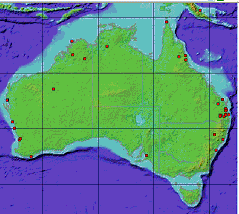Order - Fabales
Family - FabaceaeSummary:
A summer growing annual or perennial legume with long twining stems and purple or white pea type flowers.Description:
Cotyledons:Leaves:
Alternate. Tendrils.Stems:
Running vine. Branched. Twining and climbing.Flowers:
Purple or white. Pea type. 12-25 mm long.Fruit:
Flattened pod.Seeds:
Cultivar Highworth has 4000-6000 seeds/kg and Rongai has 3600-4300 seeds/kg.Roots:
Taproot.Key Characters:
Flattened pod.Biology:
Life cycle:Physiology:
Sensitive to frost.Reproduction:
By seed.Flowering times:
Spring.Seed Biology and Germination:
Vegetative Propagules:Hybrids:
Several cultivars exist including the mid season Highworth and late season Rongai.Allelopathy:
Population Dynamics and Dispersal:Habitats:
Climate:Soil:
Grows well on acid soils of low fertility and also very responsive to fertiliser.Plant Associations:
Brigalow, Coastal tropical plants.Origin and History:
Tropical areas. East Africa.Distribution:
NSW, SA, NT, QLD, WA.
Significance:
Beneficial:Detrimental:
Weed of other crops and wastelands.Toxicity:
Occasionally causes bloat.Legislation:
None.Management and Control:
Requires rotational grazing to maintain it as a pasture.Thresholds:
Eradication strategies:Herbicide resistance:
None reported.Related plants:
None in the same species in Australia.Plants of similar appearance:
Beans, Peas, Vetches.References:
Lazarides, M. and Hince, B. (1993). CSIRO handbook of economic plants of Australia. (CSIRO, Melbourne). #711.1.Acknowledgments:
Collated by HerbiGuide. Phone 08 98444064 or www.herbiguide.com.au for more information.